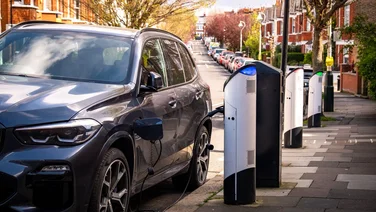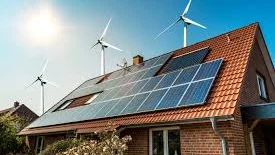Hydrogen is one of several low-carbon solutions in the UKs effort to meet net zero emissions by 2050.
As a result, the UK government has set out a strategy to integrate hydrogen into its future energy plans.
Were taking a look at what this means, how the UK government will implement its strategy, and when you can start using hydrogen-powered technologies in your home.

What is the UK hydrogen strategy?
The UK government has said it wants Britain to become a global leader on hydrogen by 2030, but how are we planning on doing this?
In short, the UKs hydrogen strategy is set to concentrate on four key areas hydrogen production, networks and storage, end-uses, and market development. Production will be the main focus, as the government wants Britain to first and foremost secure the ability to produce enough hydrogen to meet its needs.
This differs from the strategy of some other countries, which appear to be focusing on producing hydrogen almost exclusively for export. To kickstart production and work towards its goals, the UK is set to launch a £240 million Net Zero Hydrogen Fund. Right now, there is no accurate information on when this fund will start.
The fund will help subsidise the cost of production and help with the governments hydrogen business model, which will work to support hydrogen producers with long-term revenue.
Why does the UK have a hydrogen strategy?
When produced cleanly (i.e. not from fossil fuels), hydrogen is one of the greenest forms of energy we have. This makes it a prime choice in the UKs goal to reach net zero emissions by 2050.
Energy independence has also grown in importance, with the ongoing conflict in Ukraine intensifying the need to limit energy imports. Hydrogen, if the UK can reliably produce enough itself, will help achieve this.
Right now, the UK is quite over-reliant on gas to heat its homes. In fact, over 85% of UK homes (around 23 million households) are connected to mains gas which will have to change if the UK is to meet net zero ambitions by 2050.
Eventually, the UK also hopes to produce enough hydrogen to reliably export it, which would further boost the economy.

Diagram showing the process of extracting hydrogen gas from water using electrolysis
The key points from the hydrogen strategy
Hydrogen production
The production of hydrogen within Britain is one of the most important parts of the strategy, according to the UK government. Its important because being able to produce hydrogen locally will mean the UK is not reliant on gas imports.
By 2030, the UK government wants to be generating five gigawatts (GW) of energy with hydrogen this will be the equivalent of replacing natural gas power in three million homes. Both transport and heavy industry will benefit from more hydrogen production, too.
Currently, the UK only produces around 10 megawatts (MW) of energy with hydrogen, mainly in small-scale trial projects.
Networks and storage
In terms of infrastructure, the UK already has a network of hydrogen fueling stations to support existing hydrogen-powered trucks, buses, and marine vessels.
These networks will obviously have to be expanded as more vehicles switch to hydrogen power. Not only that, but assuming hydrogen completely replaces natural gas in the future, more infrastructure will be needed to accommodate the surge.
Before we talk about storage, just a quick aside about the two types of hydrogen the UK produces: blue hydrogen and green hydrogen. Blue hydrogen comes from splitting natural gas into hydrogen and CO2, while green hydrogen is created by splitting water (H2O) into hydrogen and oxygen using electricity.
But back to storage: this term refers not only to storing hydrogen fuel in its raw state, but also to capturing the carbon released from creating hydrogen fuel in the first place. Right now, around 95% of the worlds hydrogen is produced using the steam methane reforming process (SMR).
This process involves reacting natural gas with steam at a high temperature to produce carbon monoxide and hydrogen. Then, in what’s called the water-gas shift reaction, additional steam is reacted with the newly created carbon monoxide to produce more hydrogen and, unfortunately for carbon emissions, carbon dioxide.
If hydrogen is to be carbon-neutral, then carbon capture and storage (CCS) has to be an essential part of the UKs hydrogen strategy.
Another way hydrogen is produced is via electrolysis of water, but this is more costly than SMR (though one startup in Australia claims to have found a cheaper method). Thermodynamics also dictates that you will always produce less energy than you put in, meaning the energy input in electricity will be greater than the energy output of hydrogen.
End uses
Hydrogens end uses are enormous in their potential. One of the most exciting end uses of hydrogen is fueling specially created vehicles, commonly called hydrogen fuel cell cars. This is exciting because using hydrogen in a vehicle produces zero emissions by itself in fact, water is the only byproduct.
The coolest part? You can safely drink the water produced in the exhaust pipe of a hydrogen-powered vehicle (there are plenty of videos online showing people doing this). To be clear, whilst it is safe to drink, car manufacturers dont actually recommend doing so.
There is one caveat, mind you a hydrogen-powered car can only really claim to produce zero emissions overall if its powered using green hydrogen. Blue hydrogen, even with the best methods of carbon capture, is not carbon-free.
Hydrogen-powered vehicles arent new the first car to use a hydrogen fuel cell was invented all the way back in 1966. But the low availability of hydrogen as a fuel has limited the number of these vehicles on our roads.
This is changing all the time however, including for public transport. In 2021, London Mayor Sadiq Khan revealed the UKs first-ever hydrogen double decker buses, which is a major step in reducing the capitals air pollution.
Other end uses for hydrogen include:
- Ammonia production ammonia is essential for growing food
- The production of semiconductors and computer chips
- Rocket fuel
- Heating homes
Market development
Developing the existing hydrogen market in the UK is essential to helping the country adopt hydrogen on a wider scale. If the UK governments predictions come to pass, then its clear that hydrogen will play a big part in Britains economy.
The government predicts that by 2030, the hydrogen industry will support over 9,000 jobs and generate around £900 million in revenue.
This is not quite on the same scale as the 280,000 or so UK jobs in the gas and oil industries, but as these two fuels inevitably decline, jobs related to hydrogen and other clean energies will increase.
The UK government predicts that by 2050, hydrogen will be worth a whopping £13 billion to the UK economy, with a further 100,000 jobs in place to support it all.
What has the response to the hydrogen strategy been?
Numerous energy professionals have given their responses to the UKs hydrogen strategy, with the general consensus being that its a step in the right direction.
The Institute of Gas Engineers & Managers (IGEM) said they warmly welcome the publication of this much-anticipated strategy, adding that hydrogen plays a key role in decarbonising heat.
Like others however, IGEM made it clear that huge amounts of infrastructure will need to be built to provide the storage and flexibility we need to safely and securely meet the demands across industry, home heating, power generation and transport.
Regen, a not-for-profit organisation that advises companies on clean energy, took a slightly more pessimistic (or potentially realistic) view on the strategy.
They said the current strategy is still a work in progress, and whilst they agreed that there were lots of good and sensible policy suggestions, the focus on low carbon instead of zero carbon isnt ideal.
This is because the definition for what qualifies as low carbon is a little grey to say the least. Effectively, if hydrogen production is only slightly less polluting than fossil fuels, it could still qualify as being low carbon.
You can read more on what’s slowing the UK’s hydrogen revolution here.
When will you be able to buy a hydrogen boiler?
Like the overall switch to hydrogen from traditional gas, hydrogen-ready boilers will be slowly phased into the UK energy market. The earliest possible date for the first hydrogen-ready boilers in UK homes is 2023, though industry estimates reckon its more likely to be 2025.
At first, the UK government proposed introducing a blend of 20% hydrogen and 80% natural gas to the countrys mains supply. Almost all new boilers (according to British Gas) will be able to use this blend, but its not clear whether existing boilers can use it too. Thats a potential problem in the future uptake of hydrogen-ready boilers, especially since hydrogen boiler costs are a little murky at the moment.
Getting a new gas boiler costs between £2,200£4,300, typically (including installation costs). For people whove recently made this purchase, the idea of getting a brand new boiler again only so it can accept what is likely a temporary solution (the hydrogen blend) wont be too appealing.
It gets even less appealing when you realise that boiler manufacturers are currently working on 100% hydrogen-powered boilers. Very few people are likely to want to purchase a hydrogen blend boiler if the prospect of a 100% hydrogen-powered boiler is on the horizon.
Summary
Whilst the hydrogen strategy remains very much in the planning stage, its still very encouraging to see the UK making concrete steps towards moving away from natural gas. Hydrogen, being far cleaner, represents one of the best solutions in the UKs drive to net zero emissions.
Where the strategy might falter is in its ambiguous definition of low carbon, which could end up meaning hydrogen isnt quite the green solution we need. Still, if the UK government can support clean hydrogen extraction methods such as electrolysis, hydrogen could prove to be transformative.






